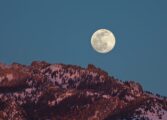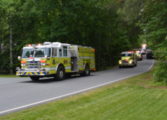Sandy Hill slave quarters linked to present day descendants
Contributed by Tricia Johnson
Correspondent
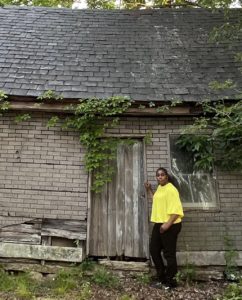
West Bottom community historian Melissa Hill visits the newly identified slave quarters where her ancestor Frederick Wood may have lived. Photos by Tricia Johnson
Nadine Armstrong looked up from her laptop. “You know there’s a slave house just down the road.” Armstrong, fellow community historian Melissa Hill, and I, the director of the Fluvanna Historical Society, were at their weekly research meeting in the fellowship hall of West Bottom Baptist Church.
Armstrong’s abrupt pronouncement sparked immediate interest. Later, she facilitated the historical society’s first visit to the small, gray-shingled building, located on an historic property called “Sandy Hill” owned by local history enthusiast Joe Ayers.
The structure, situated alone in a small meadow surrounded by oak trees, is showing its age. The slate roof sags a bit in the middle, and the house has been nearly overtaken by the verdant vines of a Piedmont summer; Virginia creeper graces the offset front door; thick ropes of poison ivy shroud the remaining chimney. Buzzards nested in the garret, but the chicks have fledged, leaving their parents behind to grumble their discontent before flying from the upper window ahead of the approach of visitors.
Ayers has been using the building to store decades worth of accumulated possessions; an old window-unit air conditioner, the skeleton of an upright piano, boxes of t-shirts from a long-ago event. The previous owner had used it as a makeshift hay barn. The last person to live in the house, Mary Scott, the community’s midwife, inhabited it during the 1940s.
And before she lived there…well. That was a question that needed answering. Had this building indeed been the dwelling place of people enslaved on that land?
Photographs of the building sent to FHS board member Benjamin Ford, principal of Rivanna Archaeological Services, brought a prompt response: an offer to reach out to his colleague archaeologist Doug Sanford of the Virginia Slave Housing Project (VSHP) to see if he and his partner Dennis Pogue would be interested in looking at the structure. A brief preliminary visit by Sanford resulted in a commitment to return to study the building in detail – to attempt to sort out whether the building was of the antebellum period, and to determine, if they could, if it had been used as housing for enslaved men, women, and children.
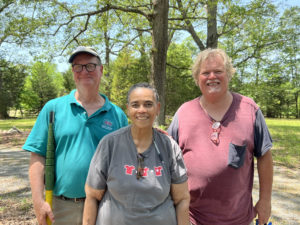
Dennis Pogue (left) and Doug Sanford (right) with West Bottom community historian Nadine Armstrong.
That study took place on June 1. Sanford and Pogue spent hours at the building on that sweltering day, taking measurements inside and out, observing construction methods and materials, recording detailed notes. Timber-frame joinery, the shape of nail heads, the tapered thickness of lapped exterior siding…the smallest details each contributed to an eventual determination.
After a break for lunch, they scrambled up to the garret space, using framing timbers as an improvised and precarious ladder to the upper floor. There they found signs that the house had once been divided into two living spaces. It was a duplex – a common configuration of housing for the enslaved in Virginia. Two families had shared the small home that offered 540 square feet of living space on the first floor and a couple of hundred more square feet in the garret. Each end had a chimney for heat and cooking; there had once been a central partition wall between the two halves of the building. An offset rear door had provided access to the left-hand side of the structure; the front door led to the right. Whitewash found on the rafters of the upper floor confirmed the garret had been used as living space and not for storage. As the hours passed, their conviction grew: this building had indeed been a home for enslaved people.
Late in the afternoon, they walked toward the much smaller building beside the main house – in laymen’s terms, a “summer kitchen.” A cursory investigation revealed similar framing methods and construction materials to the other dwelling; this prompted a decision to return in the coming weeks to study this place, as well. It was not uncommon for kitchens to be separated from main houses during that era; enslaved cooks lived in their kitchens, sleeping with their family in the garret above. So, it is possible that Sandy Hill has not one, but two extant quarters for the enslaved – twin survivors of an almost invisible era of our history, with stories to tell.
––––––––––––––
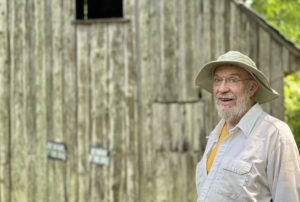
Joe Ayers of Sandy Hill standing by possible kitchen quarters.
“So much of the history of the era of slavery and the immediate aftermath of Emancipation has been, if not lost, then certainly overlooked,” said FHS board member Benjamin Ford. “To have colleagues from the Virginia Slave Housing Project study and document not one but two possible quarters for enslaved people on the same property is a gift that will deepen and broaden our understanding of this vibrant, significant community. We await their report with interest,” he added.
Ford’s colleagues, Dennis Pogue and Doug Sanford, founders of the Virginia Slave Housing Project, donate their time and expertise as they travel the Commonwealth, documenting structures relevant to the practice of slavery. They recently garnered a much wider appreciation for their work when they were featured on a “60 Minutes” report on Sharswood, a Virginia plantation recently purchased by descendants of the people who had been enslaved there. Pogue and Sanford had studied structures at Sharswood and determined that they were slave dwellings.
Pogue, a recently retired professor in the school of Architecture, Planning, and Preservation at the University of Maryland, and fellow archaeologist Doug Sanford, former chair of the historic preservation department at the University of Mary Washington, joined in a quest 15 years ago to identify and study as many of Virginia’s remaining slave dwellings as they could. Now, their work has led them to the community of West Bottom in Fluvanna County.
“When we first started off there was a question of how many were still out there,” said Pogue, who noted the team has identified more than 100 houses for enslaved workers in the Commonwealth. “There are at least that many more out there,” he added, “and I wouldn’t be surprised if there were more than that.”
Based on an intensive analysis of the 1860 US census, which recorded numbers of enslaved workers and numbers of slave houses, Sanford calculated that there were more than 100,000 slave dwellings in Virginia in 1860. So few of the structures remain today that study and preservation become more urgent.
“These buildings are going away,” explained Pogue. He pointed out that the study is not only an academic exercise but serves to “record these buildings before they are gone, and to try to give owners an incentive to preserve them.”
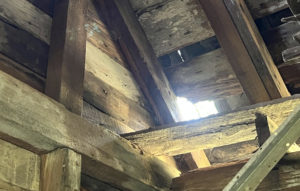
Looking up through the collapsed stairwell to the second-floor window; both joinery methods and materials used offer clues to the age of the structure.
Joe Ayers already has all of the incentive to preserve the structures that he needs. In a lifetime as a hobbyist historian, he helped found the annual batteau festival. His home at Sandy Hill has been his focus in recent years as he strives to understand the lives of all who lived there. “It is important that you go and look at Mr. Jefferson’s door at Monticello – that’s important; but it is just as important that you come here and look at the door of a humble little slave cabin that is right where it has always been,” he insisted. “This is how we connect folks with history and heritage – especially the people who live here in this community still. You can commune with your ancestors in a real, tangible way; somebody who was kin to them – someone they didn’t know- but they looked out this same door. And that will bring you closer to where you live, closer to an understanding of where we are today,” he said emphatically.
Melissa Hill, whose ancestor Frederick Wood likely lived at Sandy Hill – perhaps in the very structure that Pogue and Sanford were studying – feels the connection that Ayers described. “He might have touched this building or walked on this ground…I touched the building that he touched; I walked on the ground that he walked on. It made me feel closer to him, closer to my family.”
Frederick Wood and his wife Susan Washington were married in 1866, just after Emancipation. The 1867 personal property tax record for Fluvanna County denotes a labor contract between Wood and the then-owner of Sandy Hill, John H. Burgess, a local sawyer. After Emancipation, the formerly enslaved often inhabited slave quarters on the properties of people who hired them, so it is likely that the Woods lived at Sandy Hill, perhaps in the remaining slave quarters. One can imagine Frederick and Susan living in the humble little house; Frederick coming home from a day at the sawmill to dinner on a hot summer evening, cooked and eaten outside to thwart the heat. Susan in the upstairs garret, laboring to bring their one child, a daughter they named Nannie, into the world. This structure may be called a “slave quarters” – but it was truly a home – home to families of enslaved people, and those who experienced the eras of Emancipation, Reconstruction, and Jim Crow in the community of West Bottom.
Pogue said being able to connect with descendants of people who likely lived in a structure they are studying is “an unusual and really moving thing. All these exercises,” he added, “are about trying to understand people – people who are no longer here.” He, Sanford, and Hill had spent hours the evening before talking about the site, and Hill’s ancestors.
Sanford agreed, “We always know the potential for these interactions and stories and descendant tracing is there – but to see it happen before our eyes is very moving. This kind of descendant tracing is unusual; it is very meaningful, and it cannot happen unless someone has made these connections, and that work isn’t done by us.” Sanford commended the historical society for building relationships and engaging with residents to research the history of their community.
Both men also commended Joe Ayers for his dedication to preserve the structure and to make it available for the public to visit at some point in the future. “From our perspective as preservationists, if these buildings are gone, they are gone. And you will never have that chance again. They are part of the story,” Pogue said.
The Fluvanna Historical Society plans to collaborate with Joe Ayers on securing funding to restore the building (possibly both of them) and to ensure public access to the structures in the future.


